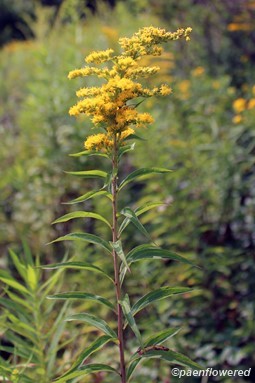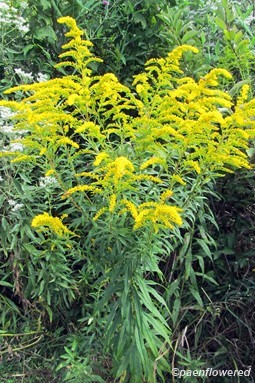Solidago gigantea
A less common goldenrod blooming in early autumn
Solidago gigantea smooth goldenrod
This is one of several perennial goldenrod species in the state that are similar and that can be difficult to distinguish. All of them have plume-shaped flower clusters, roughly shaped like a pyramid, and alternate linear leaves with parallel veins (usually 3 veins). The individual yellow compound flowers are almost identical in form in all these species. Admittedly the average person is not interested in identifying the exact species, but the purist will look closely at the features of each type. This species is one of the more common ones in bloom in early autumn.
The late goldenrod has a smooth, hairless, green, or purplish stem often covered with a whitish bloom. The leaves are usually smooth or with soft hairs. The leaves are lance-shaped and toothed, although the teeth are small and more often present on the lower leaves. The individual compound flowers have about 8-15 ray florets each. Generally, each flower head is about ¼ inch in diameter. Each elongated flower cluster is about one foot long. Late goldenrod is most easily confused with the tall goldenrod (S. altissima) that has rough leaves and hairy stems, and the Canada goldenrod (S. canadensis), which has sharply toothed leaves. It is also similar in appearance to the early goldenrod (S. jucea), but this species has mostly gone to seed by now.
The nectar and pollen attract a wide variety of insects and there are many insects that feed on the leaves of this plant. Rabbits and deer will also feed on the leaves.
This goldenrod species can be quite large, growing 2-7 feet. It will form colonies that provide good cover for wildlife. It is most often found in moist open thickets. It grows throughout continental North America except for Alaska, Arizona, Labrador and Newfoundland. It has a single main stem with branches mostly at the top. It blooms from August to October. The late goldenrod is also called the giant goldenrod.
Habitat & Range
Common in moist fields, meadows, banks, and ditches.
Present throughout the state.
| EMP: | FACW |
|---|---|
| NCNE: | FACW |
Phenology
Flowers from early August to October.
Plant Codes
S-rank: No rank
G-rank: G5 (Secure)













Comments
Have you spotted this plant in your area? We'd love to hear about your experience! Share your comments or questions about the plant below. Comments are moderated before posting.